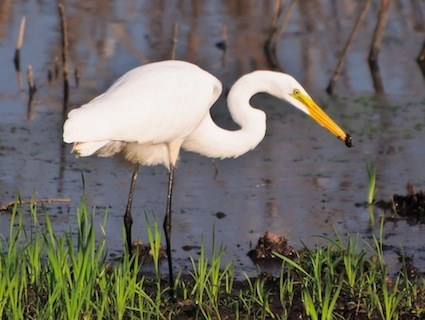Great Egrets
 WINGIN’
IT
WINGIN’
IT
By
Kate Crowley
Herons and
egrets are birds that skulk along the edges of streams, ponds and rivers
waiting for an unwary fish or frog to come within striking distance. Faster than the eye can follow, their long
necks uncoil as their beaks spear the water and their prey. You have to admire their patience as they
stand absolutely still for minutes at a time, and when they do begin to move
through the water it is almost in slow motion.
We’ve been
seeing a lot of great egrets along the banks of the Mississippi River down here
in Mississippi and Louisiana. They have
departed their summer haunts in Minnesota in advance of the coming winter, but
will remain active down here in the Delta throughout the winter months.
These birds
remind us of the disaster that nearly befell them and other water birds at the
end of the 19th Century. It
was a time when women’s fashion decreed that hats must be adorned with plumage
of all sorts, but the most elaborate and fanciful with the long, flowing
breeding plumes known as aigrettes. These
were found on the great egret, a bird that stands three feet tall, with long
black legs, an all-white body and a deadly sharp, yellow bill.
Fortunately,
there were a number of high society ladies who also loved birds and when they
were made aware of the uncontrolled slaughter (more than 95 percent of the
great egrets in North America), they became activists and ultimately stopped
the trade in feathers of all migratory birds.
They also established the Massachusetts Audubon Society in 1896 and took
the great egret as their symbol. The
National Audubon Society evolved from this group and still has the great egret
as its symbol. Because these Victorian ladies took action, in 1918 the
government enacted the Migratory Bird Treaty Act which to this day protects all
migratory birds in North America. A great lesson in the power of knowledgeable
and concerned voters.
Egrets and
herons nest in colonies called ‘rookeries’.
We have an excellent example right along I35 where it crosses the Snake
River by Pine City. Look on the west
side and you will see a cluster of very tall trees and at the tops of these are
the big stick nests of the great blue herons.
They are easiest to see in the winter when all the leaves have
fallen. Very often these types of
rookeries will have a mix of both herons and egrets nesting at different
levels. They are noisy, smelly places,
as you might imagine. When you come close to them in a boat (because they are
normally surrounded by water), you almost feel as though you’ve slipped back
into prehistory when pterodactyl’s still flew.
From the deck of
the boat, we watch great egrets fly up and down the river’s edge. They pull in their snaky neck and stick their
long legs out behind, and with slow, steady beats flap through the hazy, humid
air. There is a stretch of the Mississippi River between Baton Rouge and New
Orleans (about 85 miles long) that is known as ‘Cancer Alley’. Close to 150 plastic plants, oil refineries
and other chemical plants are located on either side of the river, which means
there are more in this small area than anywhere else in the United States. Greenpeace has labled it a Global Toxic
Hotspot. We know that industrial
accidents and accidental releases are inevitable and a common occurrences here.
High concentrations of dioxin, a known carcinogen, have been found in both the soil
and air throughout Cancer Alley. The people who live along this stretch of
river are aware of the threats to their health, but the majority are poor and
less well educated, and have little
recourse when up against the megacorporation’s that operate these plants.
I think about
the egrets that stand along the water’s edge with a forest of smokestacks,
pipes and holding tanks behind them and wonder what they are eating out of
these muddy waters. The contrast between
their slender snowy silhouettes and those of the gargantuan towers behind them are
hard to reconcile. I guess it shows the tenacity of life and how the other
creatures we share this planet with have been forced to adapt to our
world.
I think back to
those ladies who loved birds and took action to save them and wonder: do we as
a nation have the will and determination to change our ways, so that we and all
God’s creatures can live in an environment free of polluted rivers and deadly chemicals?



Comments
Post a Comment